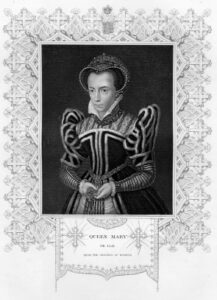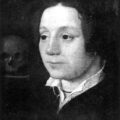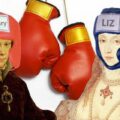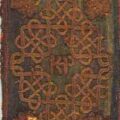
If you watched “The Tudors”, you may have been surprised by the scenes of the teenage Mary sharing a bed with her little half-sister Elizabeth, daughter of the woman she viewed as a whore, and showing affection towards her. Were these scenes just figments of Michael Hirst’s imagination?
Well, of course these scenes are fictional, we do not know that any of those loving and affectionate conversations happened but we do have evidence that Mary did dote on Elizabeth and that they had quite a sisterly relationship when Elizabeth was young – see Elizabeth and Mary Part 1 for details on that. But, things changed when Mary became Mary I Queen of England.
The Early Years
When Mary first came to the throne, amidst much rejoicing from her subjects who saw her as the true heir to the throne, everything looked very “rosy” between the sisters. As I said in Part 1, Elizabeth joined Mary in her triumphant march into London to claim the throne and Elizabeth was also given a place of honour at Mary’s coronation. Mary had a special carriage beautifully decorated for Elizabeth and Anne of Cleves, and even gave them gorgeous gowns to go with the decor of the carriage. It really looked like Mary still saw Elizabeth as her sister and as an important person, so what happened?
Tracy Borman in her book “Elizabeth’s Women” writes of how the relationship between Mary and Elizabeth disintegrated as quickly as the short-lived “euphoria” of Mary’s succession. Mary was very different to Elizabeth, both in looks and character, the two main differences being her lack of pragmatism and her belief that as a woman she was weak and needed a husband to help her govern her country. She also gave far too much authority to her councillors, because they were men who knew better than her, and also listened far too much to ambassadors like Simon Renard, the Imperial Ambassador, who loved nothing better than stirring up trouble between Mary and Elizabeth. Renard spent his time trying to convince Mary that Elizabeth was a traitor and a threat, and that she was plotting Mary’s downfall. It didn’t take much to make Mary think the worse of Elizabeth; perhaps she had inherited her father’s paranoia about threats to the throne or perhaps she had never really forgiven Elizabeth for being the daughter of Anne Boleyn. Whatever the reason behind it, Mary believed Renard and even commented that she had always thought that Elizabeth would turn out just like her mother.
As Mary became more paranoid and hostile, Elizabeth was also beginning to resent her half-sister. The very first Parliament of Mary’s reign passed an act which overturned the annulment of Mary’s parents’ marriage, making Mary legitimate. Obviously, this act still left Elizabeth a bastard and took away one of the things that the women had in common, their illegitimacy. Mary was now Henry VIII’s true daughter and rightful heir and Elizabeth was nothing but a royal bastard with no rights. The thinking behind this act and the procedure may well have stirred up the old feelings of bitterness in Mary, as she thought of the end of her parents’ marriage and her father’s passion for Anne Boleyn, and the act itself must have caused Elizabeth to feel a new resentment towards Mary.
From Bad to Worse

Things went from bad to worse when Mary, who had been listening far too much to Renard’s whisperings, made it known that she wanted to repeal Henry VIII’s statute, which had made Elizabeth next in line to the throne, and instead make her cousin, Lady Margaret Douglas, heir.
Lady Margaret Douglas was the daughter of Henry VIII’s sister, Margaret, and so was a Tudor and did have some claim to the throne but Elizabeth was Henry’s daughter! Mary and Margaret had much in common, being of a similar age and both being of the Catholic faith, and as Mary began to distrust Elizabeth more and more she gave Margaret precedence over her half-sister at court and state functions. This was a public denial of Elizabeth’s place as heir to the throne and a public display of her growing hostility.
Mary finally gave up her plan of repealing Henry VIII’s statute when her councillors advised her that she would be stirring up trouble by alienating Elizabeth. However, Renard and the Venetian ambassador, Michiel, continued being openly hostile towards Elizabeth and I would think that Elizabeth’s nose was already out of joint after her treatment at court. Elizabeth did not show her true feelings though and instead treated Mary with courtesy and respect, which must surely have been an act given Mary’s actions towards her.
Elizabeth’s parentage was not the only sticking point between the sisters, religion was also a huge problem. Mary was intent on returning England to Catholicism but Elizabeth had Protestant leanings. After Edward VI’s death, Mary did allow him to be buried with Protestant rites but insisted on a Catholic mass for his soul and invited Elizabeth and Anne of Cleves to attend. Both women failed to attend this mass and Elizabeth continued to miss mass for the next two months, infuriating Mary with her dismissal of this important religious ritual.
This lack of solidarity, and Renard’s continued whisperings about Elizabeth and how her non-attendance was a sign that she was plotting against Mary and defying her, resulted in Mary demanding that Elizabeth should attend mass on the Feast of the Nativity of the Virgin. Tracy Borman writes of how Elizabeth, who had heard that Mary was beginning to distrust her and believe that she was disloyal, wrote back to Mary asking for a private audience with her. At this audience, Elizabeth, always the wonderful actress, threw herself both figuratively and physically at her sister’s mercy, weeping on her knees in front of the Queen and begging her forgiveness for any offence that she had caused. She pleaded ignorance of the Catholic faith and its doctrines to excuse her behaviour and asked Mary to help her learn by sending her books. This was a clever ploy because it put the onus on Mary to help her, it massaged Mary’s ego and Elizabeth never actually promised to turn to the Catholic faith!
Mary would not back down over the mass of the Feast of the Nativity of the Virgin and even though Elizabeth complained of violent stomach cramps as soon as she arrived at church Mary did not let her go home. Mary was obstinate and stubborn and Elizabeth was just going to have to comply, but somehow Elizabeth managed to get away with missing more masses in the future!
As you can see, these two half-sisters had a very volatile relationship but it did get worse as Elizabeth replaced the executed Lady Jane Grey as the figurehead of rebellions and uprisings. In my next post I will write about how the sisters’ relationship deteriorated to the point where Elizabeth very nearly lost her life.











